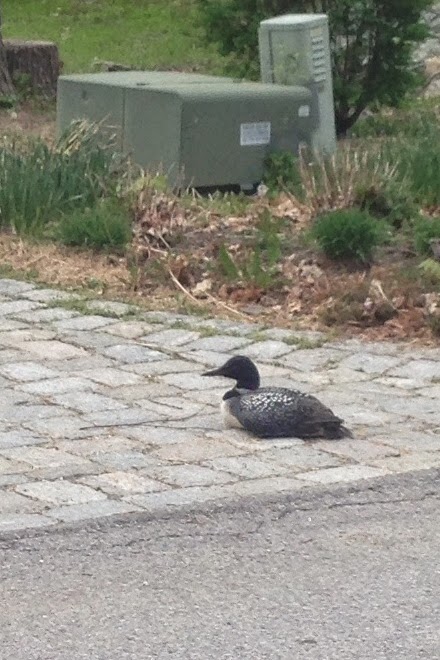“It can’t be,” I said, stopping in the middle of the street somewhere between my double- and triple-takes. I pulled Memphis’ leash tight, keeping her close to my leg. Zack, the two-year-old freeloader riding in my backpack, leaned over to see what was going on.
“Whassat?” he asked.
Just down the street, a crowd was starting to form at the epicenter of the spectacle. Two of my neighbors stood at the end of their driveway, looking down, joined by the UPS driver who’d hopped out of his truck. He also stood in the middle of the street, box in hand, motionless.
“You probably don’t remember seeing one last summer, but that,” I said to Zack, “is a loon.”
It was actually a common loon, though it seems insulting to associate the circumstances, or the bird itself, with that adjective. At this time of year, loons should be bobbing on a lake in Maine or Canada, not plopping down next to our neighbors’ mailbox, at least 200 miles from any place it might rightfully call home. A flamingo strutting around the yard might have been less out-of-place.
“Duck,” Zack said as we approached the bird. With each step, its unmistakable white speckles on black feathers became more obvious, its red eyes watching its new audience with distrust.
When our family goes on vacation to Rangeley Lake in Maine each summer, as we’ve done since I was not much older than Zack, you’re lucky to get within one-hundred yards of a loon before it slips under the water, reemerging several minutes later as a dot in the distance, which is when you sigh and put your lens cap back on. These birds know how to play hard-to-get, which is part of their allure.
If you’ll forgive me, my family is a little loony when it comes to these birds. We spend a week each year listening to their haunting calls across the lake, then swearing when we can’t get a half-decent picture of one. We make up for the lack of photographs by supporting the loon-based economy. If this bird had waddled a few more feet over to our house, he would have seen our kids’ stuffed-animal loons in the living room. My mom has loon earrings. My parents have a full-size wooden loon carving on their hearth. This family, as the regular reader(s) of this column probably know by now, appreciates a good loon.
“Well, it kind of looks like a duck, but it’s definitely a loon, buddy,” I said.
“Duck,” Zack corrected me. It’s tough arguing with someone who has the vocabulary of a parrot.
Our neighbor, Kim, walked around the yard on her cell phone, trying to locate someone who could take the bird and care for it. A larger crowd had begun to form, conjecturing about how the bird had ended up here. The loon didn’t look injured, but wouldn’t otherwise have attended an impromptu block party, and certainly not as the guest of honor. During his migration north, something must have gone south.
Kim and her husband dragged their kids’ toys out to set up a barricade, keeping the loon from wandering into the street. I waved goodbye and tried calling some local animal rescues as well. When I walked by a few minutes later, the barricade was long and high enough to host a performance of Les Misérables.
In the end, a local zoo agreed to take the loon and try to nurse it back to health. As I found out the next day, the bird hadn’t suffered any injuries, but it was skinny and had some treatable parasites. The hope is that it can be returned to the wild or live out a nice retirement at the zoo. Which, incidentally, is the only place you’d be able to get a decent picture of him.
You can visit Mike Todd in the loony bin at mikectodd@gmail.com.
Update: This story has a happy ending! Check out this post from the very awesome Trevor Zoo for some more information and pictures of the loon's release.
2 years ago





